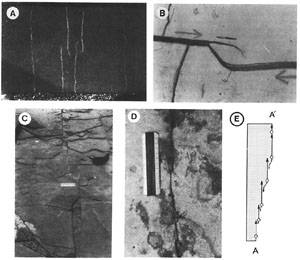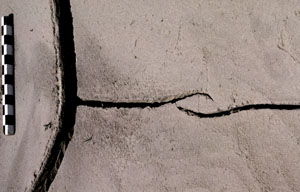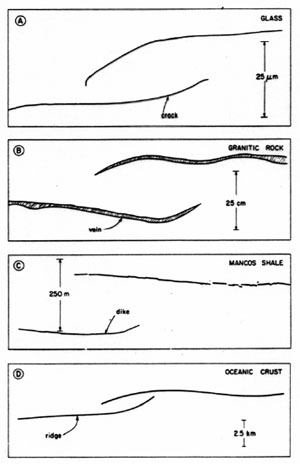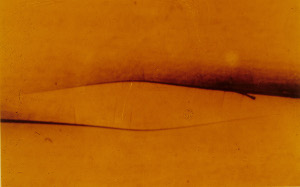| ||||||||||||
|
|
||||||||||||
|
|
||||||||||||
| Interaction of Joints | ||||||||||||
|
If the distance between two joints is small with respect to their length or height, their stress field will effect the growth of each other. For example, the four closely spaced cracks in a concrete sidewalk (Figure 1A) have interacted to inhibit each other from crossing the sidewalk entirely, while two widely spaced cracks traverse the sidewalk (Pollard and Aydin, 1988). The two interacting cracks on the right of the group of four have a characteristic hook-shaped geometry. A similar hook-shaped geometry (Figure 1B and Figure 2) occurs where two desiccation joints in mud are linked. Here plumose structures on the uppermost segments indicate that the joints propagated toward one another. The lateral propagation along a curving hook-shaped path is caused by the stress shadow of each joint pinches the tips of adjacent joints into an asymmetrical form (Pollard et al, 1982).
Such interaction of joint happens on a wide range of scale from small to large, as shown in Figure 3. A beautiful example of interacting opening mode cracks produced in the laboratory is shown in Figure 4 (courtesy of Haiqing Wu).
Examples of echelon joint zones in siltstone (Figure 1C) are linked by curved joints, by nearly straight cross joints, and even by an oblique joint that extends beyond the overlap area. The type of linking fractures does not seem to depend on the sense of step. Examples of echelon joins in sandstone (Figure 1D) consistently diverge away from the neighboring joint; although in some lava flows, new joint segments approach and then turn sharply to become parallel to older segments without linking (Figure 1E). Olson (2004) studied the 3-D effect of different degrees of joint interaction in the formation of different set or zone pattern in layered rock using numerical simulation. He credited the formation of joint zones to a delayed propagation, thus delayed interaction. For more detail of this study, please see the section Joint Spacing effected by Rock Subcritical Index. | ||||||||||||
| Types of Interaction of Joints: | ||||||||||||
| Growth of Joint Arrays - Fracture Saturation and Fracture Infilling | ||||||||||||
| Reference: |
||||||||||||
| Olson, J., 2004 Pollard, D.D., Segall, P., Delaney, P.T., 1982 Pollard, D.D., Aydin, A., 1988 |
||||||||||||
|
Readme | About Us | Acknowledgement | How to Cite | Terms of Use | Ⓒ Rock Fracture Knowledgebase |
||||||||||||



